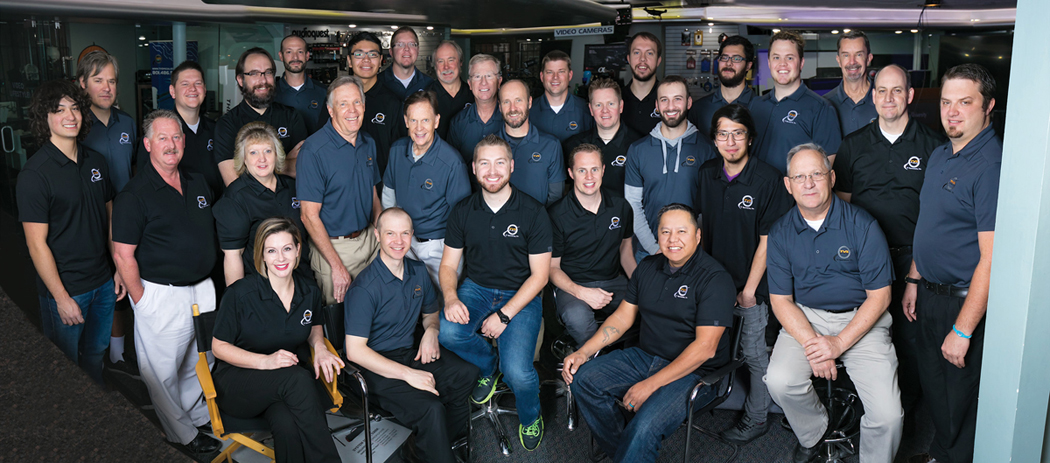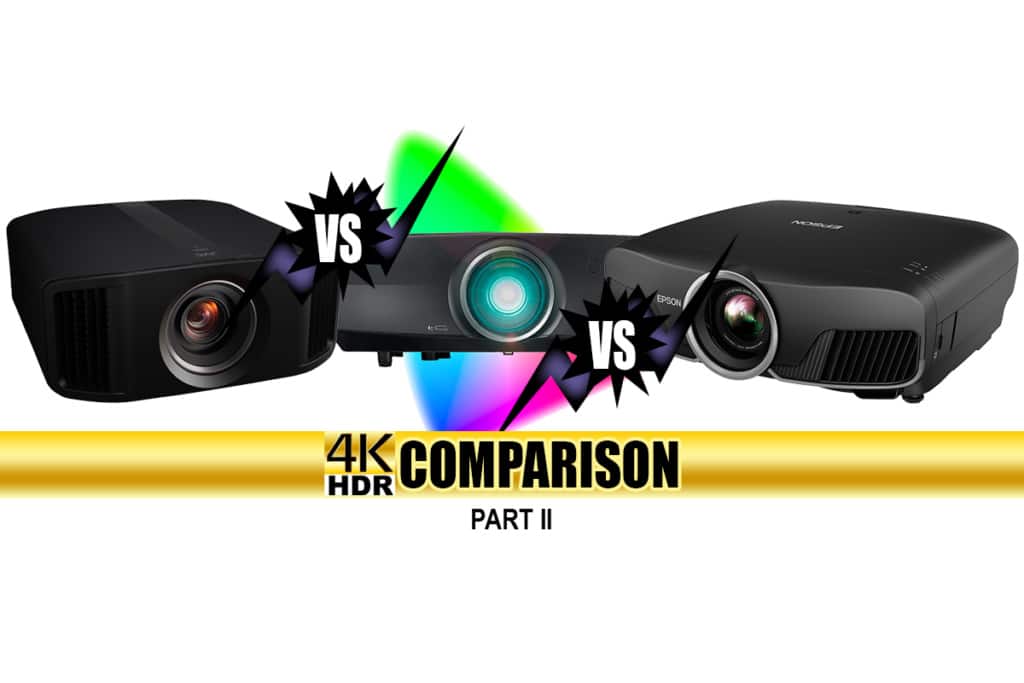AV Solutions, Home Theater
JVC DLA-NX7 vs Epson Pro Cinema 6050UB vs TVS Pro Theo-Z65 (Part II)
If you haven’t read the 1st part of this blog post, we recommend reading it first.
JVC DLA-NX7 vs Epson Pro Cinema 6050UB vs TVS Pro Theo-Z65 (Part I)
Color and Wide Color Gamut
All three of these projectors feature wide color gamuts which give great life and excitement to many scenes. REC 709, the standard for Bluray and HD sources, was chosen in 1990 and represented the new capability of the High Definition standard. Today, modern display systems, including these projectors, have the capability of going far beyond those standards. 4K with HDR at 10 bits allows a much wider range and extended display of color. The goal of REC 2020 is to display most or all of the colors we see in nature – also called the painters gamut. While a projector or display with REC 709 may display up to about 56% of REC 2020, all three of these projectors display over 70% of REC 2020.

Since all three of these projectors are able to display excellent color, we measured the wide color gamut within the REC 2020 color space to see how each of the projectors did. Although there are some differences, which you may or may not be able to see from these images, all do an amazingly good job and put projectors without this capability in a whole different category if viewed side by side. Some even have asked why we did not choose to compare the JVC NX5 in this comparison since it is closer in price to the Epson Pro Cinema 6050UB and Theo-Z65. The reason is color, wide color to be specific. JVC understands the value of deep, rich, wide color and is really the main difference between the NX5 and the NX7. There is also a difference in 100 lumens of light output (almost undetectable) and contrast ratio but that is minor compared to the color differences.





Blu-ray and HD Scaling to 4K UHD
One of the great things about wide color and 4K displays is the ability to see your existing HD content in a whole new light. Up until just a few years ago, most projectors and even flat panels did not do all of the REC 709 standard of color. Now that many 4K displays are trying to reach P3 color, many are now doing most, or all, of the HD color space, and it is exciting to see all the colors we have been missing. As part of this up-conversion or scaling process, however, the image must go through a processing engine to map the pixels to the 4K display. The results in this case were a bit of a disappointment for the JVC DLA-NX7, as it could not do a smooth and life-like conversion.



In terms of what this looks like in an actual image, we saw an increase of processing noise in the image and an almost cartoon-like look to images, shading, and detail on the JVC. Please keep in mind this only applies to sources that are HD or Blu-ray HD. It may have something to do with the fact that almost all HD and Blu-ray HD sources are only 8-bit in terms of bit depth. But, whatever the case, the results are very noticeable on most images from these sources. It will help to look at these images here at larger sizes by clicking on them.



Conclusions and Results
When we decided to test all three of these together it was mainly because all three claimed a wide color gamut (why we modified the UHZ65 in the first place). We did not expect to see so many similarities and even had a few surprises in terms of 4K detail and contrast. All of these projectors have incredible color and one would be very wrong to suggest otherwise. 4K HDR sources look amazing and, if in separate rooms, one would have a very difficult time comparing them at HD viewing distances of 3-5 times the screen height. If, however, viewed at 4K viewing distances (1.5 to 2.5 times screen height) as some are now beginning to do, the differences would begin to show for most viewers.
The JVC DLA-NX7, without question, had the best blacks – as would be expected from its reputation. The HDR Auto Tone Mapping was a very nice improvement over previous HDR implementations. The color was very good, covering 99% of the P3 standard, and over 70% of the BT2020 color.This is a very sophisticated and well-refined projector with lens memory, detailed menu, and very good 4K detail. The JVC DLA-NX7 works best in a very controlled environment such as a dedicated theater room with a dark interior. For best HDR performance we would recommend a screen size of under 120″. You could go larger for non-HDR sources, but for HDR 4K it is best to stay under 120″. If you have the budget for the DLA-NX7, it will not disappoint as you are getting state-of-the-art performance. On the downside, it is a lamp-based projector, and, like all lamp-based projectors, the brightness and color will change over time – especially in the first couple of hundred hours. Additionally, the lamps are rather expensive (at over $500 each). The 4K scaling too, was disappointing – but this can be compensated for with an outboard scaling processor or 4K HDR Blu-ray player with good scaling. In the high lamp position, as was used in this comparison, the fan noise is noticeable and may be objectionable for some.
The Epson Pro Cinema 6050UB is a slightly-higher contrast version of the new 5050UB and comes with the extra lamp, ceiling mount, cable cover, and an additional one year of warranty making a total of 3 years of coverage. In this case, it was the contrast and brightness that really did impress us for an LCD projector. The wide color was good, the lens has a memory and is motorized, and it even has a respectable game mode for faster response time. It is ideal for those wanting the wider color and HDR performance and will be watching at distances typical of HD displays (3-5 times screen height). It is also ideal for those who want very large screens above 130,” or those who would run in low-lamp mode and keep the size under 110,” or maybe 130″ in the middle lamp mode. The advantage of low-lamp mode is considerably long lamp time (usually 1,000 hours or more) and a much quieter environment. The negatives, like the JVC DLA-NX7 and all lamp-based projectors, are the brightness and color drifting over the first couple of hundred hours. Other challenges would be the screen door effect at closer distances and the fan noise (if used in the highest position for maximum brightness). It is also not as detailed and capable of displaying the full detail of 4K sources due to the native 1080p panels used for the 4K enhancement – but is still very sharp and bright.
Because we developed the modifications to the Optoma UHZ65 we are definitely biased, but we have tried to let the images tell the story. We are convinced that solid state light source projectors, like this one, are the future. Not only are they almost maintenance-free, but the brightness and color stability is a drastic improvement over lamp-based technology. We were pleased to see that we still have one of the best color gamuts in the industry. And, because of the unique properties of laser/phosphor used in this projector, it has significantly better blues, cyans, and greens. The scaling of HD sources and HD Blu-ray discs was impressive and clearly the best in this comparison. The contrast is excellent and competes very well. The blacks, while not quite as good as the JVC DLA-NX7, are definitely much better than we had realized, and, in all but the darkest of scenes, compete very well. We also love the compact size and how quiet it is (full brightness fan noise is about the same as the JVC DLA-NX7 and Epson Pro Cinema 6050UB in their low lamp modes) along with the light weight and ease of installation (largely due to the smaller size). On the downside, some people are sensitive to the rainbow effect of the color whee, the lens is not motorized with memory, and the processing speed is not the best for serious gamers.
As mentioned in the beginning, it was never our purpose to select a clear winner. Each projector has its own unique characteristics and is best suited to specific applications. Our purpose in doing these comparisons is to help our customers make informed and knowledgeable decisions for their situation. We always welcome visitors and do in-store comparisons on a daily basis. If you are in the market for a mid to high level 4K projector, please consider our “Projector Challenge” which will allow you to compare in-person before you make a purchase.
Theo Charts







